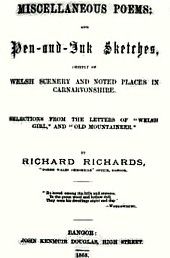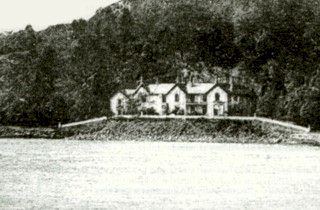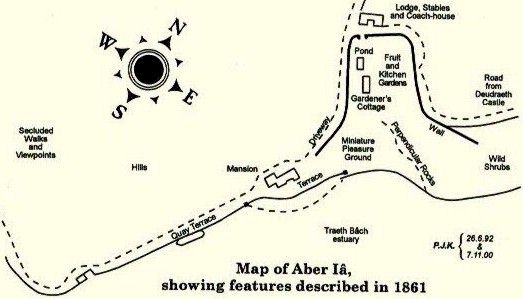
AND PEN-AND-INK SKETCHES"
BY RICHARD RICHARDS
published 1868, Bangor
Map and editing by Phil Kendrick, 2006


One day last week, I decided
to cross over the "cob" from Portmadoc to the pleasant though straggling little
village of Penrhyndeudraeth. To the uninitiated in local
topography, the term "cob" is a word employed to denote the famous embankment
over the Traeth Mawr estuary, built at great expense (£100,000 it is said) by the late Mr.
[William Alexander] Madocks. There was a stiff north-easter blowing and sweeping
down from the snow-covered mountains of Merionethshire, as I prudently took the lower, or
carriage road, compartment of the cob.
The two Traeths run up into the mountains in a northerly direction, in parallel lines for five or six miles and they are separated by a hilly slope of land. On this long-tongued but nameless peninsula, is situated the village of Penrhyn and in a snug, rocky alcove on the side of Traeth Bach is to be found (I say "found" advisedly, because the rambler will not drop upon it by chance) — Aber la.
Aber la is to be spoken as if written Abber-yah. I started towards the end of the peninsula. Afterwards I found myself on the road running on from Deudraeth Castle, and then there was a fine building in front — the Lodge, with the stables adjoining, the latter being built with all the most modern improvements. But no smoke rose from its chimneys nor was there a living thing of any kind.
The walks appeared to be tastefully planned out by some party or parties. I opened a door which led into the garden and a house in the centre of it. Neither man nor woman was there, only a number of foreign water-fowl on a tiny pond, and two monkeys, which by their cries evidently regarded me as an unwelcome intruder. The garden itself was a very fine one, the walls of which were netted all over with fruit trees. A visit to this enchanting place would have been much more agreeable in the earlier part of Autumn than on a piercingly cold day in January, with icicles in abundance.
I felt myself freezing fast. In my desperate wrath I abruptly quitted the garden, and proceeded along a gently-sloping path — anywhere, to any spot, rather than remain in that cold, silent, and fruitless garden. I had not proceeded more than a few yards when on turning round a small curve to the right, to my glad surprise I espied a splendid mansion in front, and close by on the very edge of the sea, but which the inequalities of the ground had up to the last moment concealed from my view. I at once felt, instinctively, that this was the real Aber la — and I was right. In a few moments afterwards I found myself sitting by a bright and glowing fire, and soon became if not absolutely warm yet a little less cold.
Aber la, then, gentle reader, is a beautiful mansion on the shore of Traeth Bach, in Merionethshire. It was built by the late Mr. [Henry Seymour] Westmacott at very great cost, and with exquisite taste and judgment. It is one of the most picturesque of all the summer residences to be found on the sea-coast of Wales.
The site has a south-east aspect, and it is completely sheltered from the north and west winds by hills immediately in its rear, and partly so to the east by a rocky escarpment which bulges out a little way into the Traeth. These projecting rocks have very irregular surfaces and are completely covered over with purple heath, gorse, and other wild shrubs. Immediately in front of the Villa and for a distance of 200 yards or so parallel with the beach, there is a raised terrace about twenty feet in height. This terrace with its shrubs, statuettes, and other ornamental appendages, is one of the chief features of the place, and must have entailed an enormous outlay as well as time and labour.
At the northern end of the terrace is a miniature pleasure ground (also raised) bounded by perpendicular rocks, and which abounds in cascades, water jets, romantic footpaths, and a great variety of costly native and foreign shrubs and flowers. There is thus a mingled blending of art and nature, and the effect is perfect. Above the merely ornamental portion of the grounds, are situate the fruit and the kitchen gardens, the aspect of which is all which could be desired. My informant told me that the climate was very mild (which I felt much inclined to doubt); and as a proof he shewed me a hardy exotic plant from New Zealand which was flourishing in the open ground. The rocks facing the Traeth are quite perpendicular to a certain height; but on the summit and along the sides of them there has been made a number of secluded walks of the most romantic character, leading to elevated spots where the best views may be had of the Villa, the Traeth, the surrounding mountains, and in one place, of Cardigan Bay. Cold and bleak as was the day, and leafless as were the trees, I greatly enjoyed the magnificent views from these rocks, and admired the skill of the “cunning hand” which had planned out those delightful walks.
We returned to the warm fire awaiting us, and which we poked up with very considerable vigour and determination. I was then "shewn over" the inside of the fairy retreat. It was a perfect "curiosity shop" and something more than that. There was a great deal of carved work, and the plate glass I thought was in too great an abundance. Amongst other articles of ‘vertu’ I was shewn a magnificent sideboard, made at Vienna, and which gained a prize at the Great Exhibition in London, in 1851, and for which Mr. Westmacott gave 600 guineas. In the midst of all this beauty and splendour and which had occasioned so much expense and trouble to accumulate, I could not help feeling regret that the gentleman by whom it was all accomplished, died just as the plans he had projected and carried out were all but completed. Such is often the end of earthly hopes and human expectations.